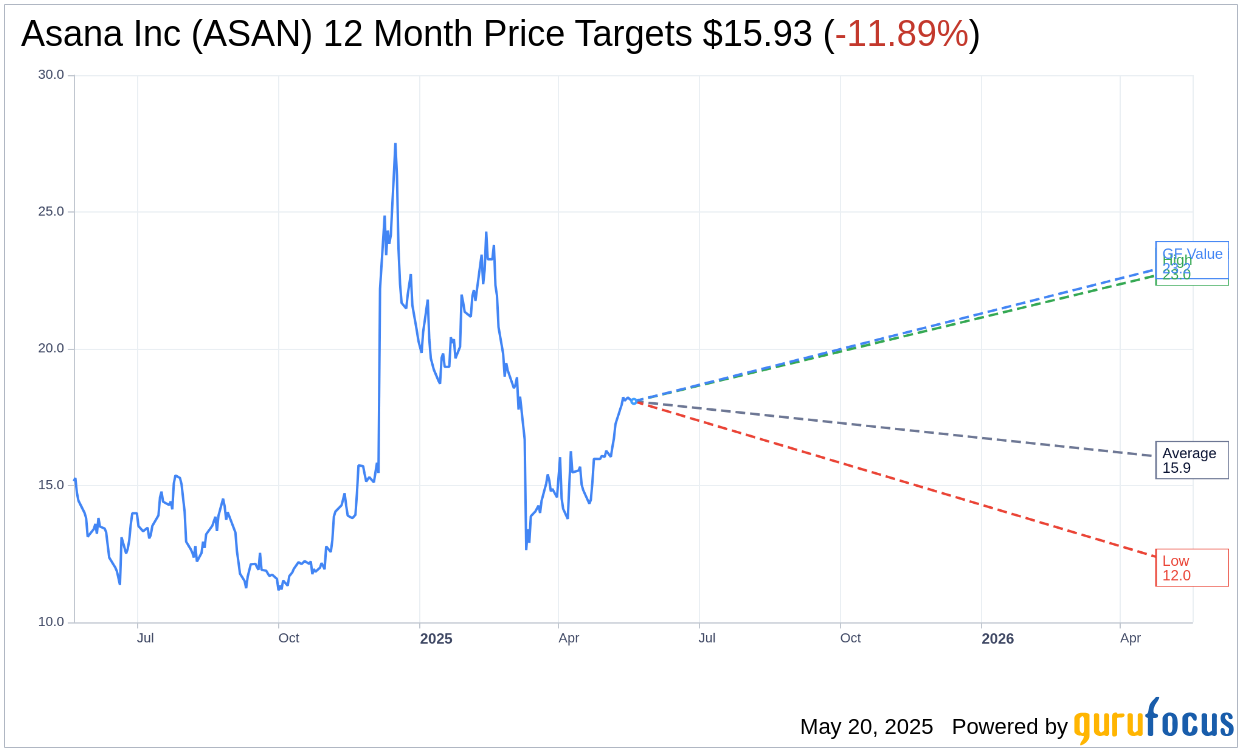Morgan Stanley has revised its rating for Asana (ASAN, Financial), moving it from Equal Weight to Underweight while maintaining the price target at $14. This decision follows a notable rise of over 40% in Asana's stock since the day after its Q4 earnings, a significant outperformance compared to a 6% increase in the broader SMID-cap software sector.
The firm argues that current market conditions and channel checks do not suggest an improvement in Asana's fundamentals. Furthermore, competitive pressures are mounting, with Asana reportedly losing market share to rivals like Monday.com and other private entities in the collaborative work management space. Morgan Stanley also highlights ongoing leadership uncertainty at Asana, which is in the process of searching for a new CEO, as a factor that could impact execution and strategic direction.
Wall Street Analysts Forecast

Based on the one-year price targets offered by 13 analysts, the average target price for Asana Inc (ASAN, Financial) is $15.93 with a high estimate of $23.00 and a low estimate of $12.00. The average target implies an downside of 11.89% from the current price of $18.08. More detailed estimate data can be found on the Asana Inc (ASAN) Forecast page.
Based on the consensus recommendation from 18 brokerage firms, Asana Inc's (ASAN, Financial) average brokerage recommendation is currently 2.8, indicating "Hold" status. The rating scale ranges from 1 to 5, where 1 signifies Strong Buy, and 5 denotes Sell.
Based on GuruFocus estimates, the estimated GF Value for Asana Inc (ASAN, Financial) in one year is $23.24, suggesting a upside of 28.54% from the current price of $18.08. GF Value is GuruFocus' estimate of the fair value that the stock should be traded at. It is calculated based on the historical multiples the stock has traded at previously, as well as past business growth and the future estimates of the business' performance. More detailed data can be found on the Asana Inc (ASAN) Summary page.
ASAN Key Business Developments
Release Date: March 10, 2025
- Q4 Revenue: $188.3 million, up 10% year over year.
- Adjusted Revenue: $189.1 million, up 10.5% year over year when adjusted for currency impact.
- Non-GAAP Operating Margin: Improved by over 800 basis points year over year to an operating loss margin of 1%.
- Gross Margin: 90%.
- Net Loss: $438,000, with a net loss per share of $0.00.
- Free Cash Flow: $12.3 million for Q4, with a full fiscal year free cash flow of $2.6 million.
- Core Customers: 24,062 customers spending $5,000 or more annually, with revenue from this cohort growing 11% year over year.
- $100,000+ Customers: 726 customers, growing 20% year over year.
- Dollar-Based Net Retention Rate: Overall 96%, with core customers at 97%.
- Fiscal Year Revenue: $723.9 million, up 11% year over year.
- Cash and Marketable Securities: $466.9 million at the end of Q4.
- Remaining Performance Obligations (RPO): $430.8 million, up 23% year over year.
- Q1 Fiscal '26 Revenue Guidance: $184.5 million to $186.5 million, representing 7% to 8% growth year over year.
- Full Fiscal Year 2026 Revenue Guidance: $782 million to $790 million, representing 8% to 9% growth year over year.
- Non-GAAP Operating Margin Guidance for Fiscal Year 2026: At least 5%.
For the complete transcript of the earnings call, please refer to the full earnings call transcript.
Positive Points
- Asana Inc (ASAN, Financial) reported a 10% year-over-year increase in Q4 revenues, exceeding the top end of their guidance when adjusted for currency impacts.
- The company achieved a significant milestone by reaching positive free cash flow for the full fiscal year 2025.
- Non-GAAP operating margins improved by over 800 basis points year-over-year, with expectations to reach non-GAAP profitability in Q1 of the next fiscal year.
- Asana Inc (ASAN) saw a 20% year-over-year growth in customers spending $100,000 or more, indicating strong enterprise customer acquisition.
- AI Studio, Asana's new product offering, has shown promising early adoption, with thousands of customers enabling it and significant demand across various industries.
Negative Points
- The company's overall dollar-based net retention rate was 96%, indicating challenges in expanding existing customer accounts.
- Asana Inc (ASAN) experienced macroeconomic headwinds, particularly in the technology sector, impacting their growth and expansion efforts.
- The company had to make the difficult decision to reduce its workforce by approximately 5% to align costs with strategic priorities.
- Despite strong RPO growth, a significant portion of Asana's business is on monthly billings, which is not reflected in RPO metrics, potentially impacting revenue visibility.
- The guidance for fiscal year 2026 indicates a modest revenue growth rate of 8% to 9%, which is lower than the market's double-digit growth expectations.
